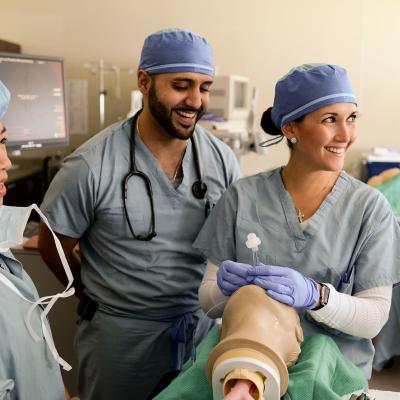- AdventHealth University

Updated July 29, 2025.
In 2024, there were over 3.6 million births in the United States, according to data from the CDC, that means nearly 10,000 babies are born every day.
For most of those births, labor and delivery nurses played an important role in the successful delivery of healthy babies. They also helped mothers and their newborns navigate medical concerns before, during, and after delivery. This makes labor and delivery nurses fundamental members of the health care system and trusted professionals in the eyes of mothers, children and their families.
Labor and Delivery Nurses
The role of a labor and delivery nurse is challenging and requires an advanced education, as well as mastery of several medical skill sets. It is also highly rewarding, enabling professionals to make a positive impact on the lives of patients and newborns every single day.
Labor and delivery nurses are involved in multiple aspects of the birth planning and delivery process. They are responsible for educating expectant mothers and their families about the birthing process, evaluating the needs of each individual patient, monitoring the mother’s and baby’s health and vital signs throughout the birthing process, and providing medication and epidurals as needed. Labor and delivery nurses can work in different settings. Many work at hospitals, while others hold positions with specialized birthing centers.
Labor and Delivery Nurse Salary
The average annual salary of labor and delivery nurses in the U.S. is about $96,000. However, salaries can range depending on factors such as location, level of education, and years of experience.
How Do You Become a Labor and Delivery Nurse?
The first step to becoming a labor and delivery nurse is to earn an associate or bachelor’s degree in nursing. While some health organizations hire individuals with an associate degree, earning a Bachelor of Science in Nursing (BSN) helps you secure more competitive jobs and potentially earn higher salaries.
The next step is passing the National Council Licensure Examination (NCLEX-RN) to become a registered nurse. After passing the exam, professionals can begin working as registered nurses and gain valuable on-the-job experience.
As nurses progress through their careers, they can choose to further their education by earning additional credentials or a Master of Science in Nursing (MSN) degree. These programs typically offer opportunities for specialization in fields such as obstetrics and gynecology, pediatrics, and family nursing.
In addition, gaining experience as a nurse practitioner or nurse midwife can provide a competitive advantage to those interested in the labor and delivery field. The most successful labor and delivery nursing candidates ultimately possess a strong combination of work experience, education, and diverse nursing skills.
Labor and Delivery Nurses’ Job Duties and Responsibilities
To succeed as a labor and delivery nurse, you must have a diverse skill set and the ability to work well in high-pressure situations. Some of the duties and responsibilities of labor and delivery nursing include:
Monitoring Vital Signs During Labor
To ensure a healthy and successful delivery process, labor and delivery nurses are responsible for monitoring the vital signs of both mother and baby. If a nurse notices that a mother’s body temperature is above a safe level or that a baby’s vital signs are below the recommended level, they can help guide and administer a different course of action as part of the labor and delivery team.
Administering Medications
Labor and delivery nurses are also responsible for administering medications during labor and delivery. This may include administering oral and intravenous medications per a physician’s orders. These medications can treat pain, nausea, changes in blood pressure or any other symptoms that need to be addressed.
Preparing for Birth
A labor and delivery nurse closely monitors the time between contractions, which is essential for administering necessary procedures at each stage of the birthing process. They anticipate when to set up the delivery room and prepare the mother for delivery.
Inducing Labor
Labor and delivery nurses play a key part when a doctor decides labor needs to be medically induced. Under a doctor's guidance, the nurse often administers medications that help initiate or strengthen contractions or medication to prepare the mother's body for labor. They carefully monitor the mother's temperature, heart rate and blood pressure, as well as the frequency and intensity of her contractions. The nurses will monitor labor progress, explain the situation to the mother and family, offer comfort and encouragement, and collaborate closely with the doctor to ensure a safe delivery.
Providing Encouragement and Support
Nurses go beyond ensuring that an expectant mother and her newborn are in the best of health. They also provide mental and emotional support for mothers throughout the labor and delivery process. After birth, labor and delivery nurses are essential in helping new parents bond with their newborns and addressing any physical or emotional concerns they may have.
Aiding in Delivery
Labor and delivery nurses can assist obstetricians in many ways, making sure delivery goes smoothly and addressing any unexpected concerns throughout the process. They can assist with both natural births and Cesarean sections.
Further Your Nursing Career Through Higher Education at AHU
Skilled labor and delivery nurses will remain in high demand throughout the coming decades. Health organizations will seek to hire dedicated nurses who possess the highest levels of experience and credentials.
If you want a competitive advantage and higher salaries, pursuing higher education is a reliable way to acquire additional nursing skills and higher pay. AdventHealth University offers three programs, AS Nursing, BS Nursing and MS Nursing (Online), all of which are designed to prepare you for a career in nursing. If you're interested in learning more about any of our nursing programs or how to become a labor and delivery nurse, you canrequest information. A member of our team will reach out to you to answer any questions you may have and help you get started on the first steps.


